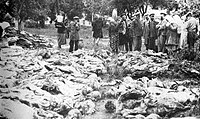
Photo from wikipedia
I present a realist theory of subversion among great powers, an understudied phenomenon in the burgeoning literature on subversive statecraft. I show that a simple, rational cost-benefit calculus accounts for… Click to show full abstract
I present a realist theory of subversion among great powers, an understudied phenomenon in the burgeoning literature on subversive statecraft. I show that a simple, rational cost-benefit calculus accounts for comparatively low-levels of subversion among non-belligerent great powers, much higher levels among belligerent great powers, and more frequent, violent and larger-scale subversion against weaker targets. Brief case studies of mid-twentieth century subversion featuring the Soviet Union and the United States illustrate the theory and provide preliminary support. Theory and evidence show that the conditions that are conducive to highly consequential subversion among great powers are quite limited and reversible. This gives rise to skepticism concerning claims that today’s strategic environment has fundamentally transformed the nature of great power rivalry so as to accord a newly central place to subversion.
Journal Title: International Relations
Year Published: 2020
Link to full text (if available)
Share on Social Media: Sign Up to like & get
recommendations!